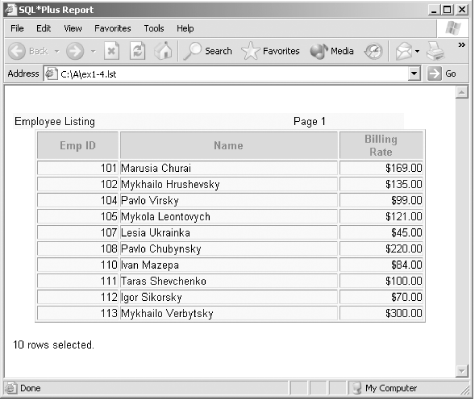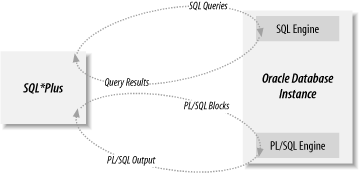SQL*Plus is the command-line interface to the Oracle database. It exists to let you enter and execute ad hoc SQL statements and PL/SQL code blocks, and, if you're a database administrator (DBA), to issue database administration commands such as STARTUP and SHUTDOWN. This chapter explains what SQL*Plus is, how it relates to the Oracle database, and why you should master it. At the end of the chapter, I'll introduce you to the sample data used for many of the examples in this book. You can load the data and follow along as you read.
SQL*Plus is essentially an interactive query tool with some scripting capabilities. You can enter a SQL statement, such as a SELECT query, and view the results. You can execute data definition language (DDL) statements to create tables and other objects. DBAs can use SQL*Plus to start up, shut down, and otherwise administer a database. You can even enter and execute PL/SQL code.
SQL*Plus is primarily a command-line application, but, despite its lack of "flash," it is a workhorse tool used daily by database administrators, developers, and yes, even end users. As a DBA, it is my tool of choice for managing the databases under my care. I use it to peek under the hoodâto explore the physical implementation of my database, and to create and manage users, tables, and tablespaces. In my role as a developer, SQL*Plus is the first tool that I fire up when I need to develop a query. In spite of all the fancy, GUI-based SQL generators contained in products such as PowerBuilder, Clear Access, and Crystal Reports, I still find it quicker and easier to build up and test a complex query in SQL*Plus before transferring it to whatever development tool I am using.
Originally developed simply as a way to enter queries and see results, SQL*Plus has been enhanced with scripting and formatting capabilities and can be used for many different purposes. The basic functionality is simple. With SQL*Plus, you can do the following:
Issue a SELECT query and view the results.
Insert, update, and delete data from database tables.
Submit PL/SQL blocks to the Oracle server for execution.
Issue DDL statements, such as those used to create, alter, or drop database objects (e.g., tables, indexes, and users), as well as any other types of SQL statements that Oracle supports.
Execute SQL*Plus script files.
Write output to a file.
Execute procedures and functions that are stored in a database.
While these operations may not seem significant, they are the building blocks you can use to perform various useful functions.
Consider the ability to enter a SELECT statement and view the results. Example 1-1 shows how to do this using SQL*Plus.
Example 1-1. Executing a query in SQL*Plus
SQL>SELECT employee_id, employee_name, employee_billing_rate2FROM employee;EMPLOYEE_ID EMPLOYEE_NAME EMPLOYEE_BILLING_RATE ----------- ---------------------------------------- --------------------- 101 Marusia Churai 169 102 Mykhailo Hrushevsky 135 104 Pavlo Virsky 99 105 Mykola Leontovych 121 107 Lesia Ukrainka 45 108 Pavlo Chubynsky 220 110 Ivan Mazepa 84 111 Taras Shevchenko 100 112 Igor Sikorsky 70 113 Mykhailo Verbytsky 300
Combine this capability with SQL*Plus's formatting abilities and you can turn these results into a credible-looking report, such as that shown in Example 1-2, complete with page titles, page numbers, column titles, and nicely formatted output.
Example 1-2. A SQL*Plus formatted report
Employee Listing Page 1
Billing
Emp ID Name Rate
---------- ------------------- --------
101 Marusia Churai $169.00
102 Mykhailo Hrushevsky $135.00
104 Pavlo Virsky $99.00
105 Mykola Leontovych $121.00
107 Lesia Ukrainka $45.00
108 Pavlo Chubynsky $220.00
110 Ivan Mazepa $84.00
111 Taras Shevchenko $100.00
112 Igor Sikorsky $70.00
113 Mykhailo Verbytsky $300.00Another twist on the same theme is to format the output as a list of comma-separated values, such as that shown in Example 1-3.
Example 1-3. Comma-separated values from SQL*Plus
101,"Marusia Churai",169 102,"Mykhailo Hrushevsky",135 104,"Pavlo Virsky",99 105,"Mykola Leontovych",121 107,"Lesia Ukrainka",45 108,"Pavlo Chubynsky",220 110,"Ivan Mazepa",84 111,"Taras Shevchenko",100 112,"Igor Sikorsky",70 113,"Mykhailo Verbytsky",300
Using the SQL*Plus SPOOL command, which you'll read more about in Chapter 5, you can write this output to a .csv file easily readable by most, if not all, spreadsheet programs. In fact, if you are running Microsoft Windows with Microsoft Office installed, simply double-clicking on a .csv file will open that file in Microsoft Excel, where you can further manipulate the data.
Beginning with SQL*Plus in Oracle8i Database, you can use the SET MARKUP HTML command to generate HMTL output, such as that shown in Example 1-4.
Example 1-4. A SQL*Plus report formatted in HTML
<html>
<head>
<meta http-equiv="Content-Type" content="text/html;
charset=US-ASCII">
<meta name="generator" content="SQL*Plus 10.1.0">
<style type='text/css'> body {font:10pt Arial,Helvetica,
sans-serif; color:black; background:White;}
...
<tr>
<td align="right">
101
</td>
<td>
Marusia Churai
</td>
<td align="right">
$169.00
</td>
</tr>
<tr>
<td align="right">
102
</td>
<td>
Mykhailo Hrushevsky
</td>
...By writing such HTML output to a file, you can easily generate ad hoc reports for users to view from a corporate intranet. One DBA whom I spoke with regularly refreshes the phone list on his departmental intranet using this mechanism. Figure 1-1 shows the output in Example 1-4 as you would see it rendered in a browser.
It's a small leap from executing only queries to executing any other SQL statement. In fact, SQL*Plus will let you execute any valid SQL statement and is frequently used during database maintenance tasks. For example, you can create a new user with the following statement:
CREATE USER sql_dude IDENTIFIED BY some_password;
Of course, it's rare that you would issue such a simple statement, or just one statement, when you add a new user. Usually, you also want to assign a default tablespace and often a quota on that tablespace. You may also want to grant the privilege needed to connect to the database. Whenever you have a task that requires a sequence of statements to be executed, you can simplify things by taking advantage of SQL*Plus's scripting capabilities. The statements in Example 1-5, when placed in a script file, allow you to add a new user with just one command.
The &&1, &&2, and &&3 in Example 1-5 are SQL*Plus user
variables marking the locations at which to insert parameters that you
pass to the script. Assuming that you give the name create_user.s ql to
the file shown in Example
1-5, and assuming that you are the DBA, you can issue the
following command from SQL*Plus whenever you need to add a user to
your database:
@create_user username password quotaExample 1-6 shows
how this works, by creating a user named sql_dude with a password of yooper and a quota of 10 megabytes.
The output you see is SQL*Plus showing you the before and after version of each line containing a SQL*Plus user variable. You will read more about user variables and the subject of scripting in Chapter 8.
To write complicated scripts, you can take advantage of Oracle's built-in procedural language, PL/SQL. Example 1-7 shows a simple PL/SQL block being executed from SQL*Plus.
You've just seen several examples of what can be done using SQL*Plus to generate simple text reports, perform database administration tasks, extract data, generate HTML reports, run automated scripts, and otherwise make your life easier. Subsequent chapters delve deeply into each of these areas and more.
SQL*Plus is often used in conjunction with two other products, both of which have the letters "SQL" in their names. The first is SQL itself. Without a doubt, the most common use of SQL*Plus is to submit SQL statements to the database for execution. The second product is Oracle's PL/SQL procedural language. Table 1-1 provides a short summary of each of these three products.
Table 1-1. The three SQLs: SQL, PL/SQL, and SQL*Plus
Product | Description |
|---|---|
SQL | SQL is an ANSI and ISO standard language used to insert, delete, update, and retrieve data from relational databases. SQL is also used to manage relational databases. |
PL/SQL | PL/SQL is a proprietary procedural language developed by Oracle as an extension to SQL, for use in coding business rules and other procedural logic at the database level. Like SQL, PL/SQL executes inside the database engine. |
SQL*Plus | SQL*Plus is an Oracle-developed tool that allows you to interactively enter and execute SQL commands and PL/SQL blocks. |
Because these three products all have "SQL" as part of their names, people occasionally get confused about the relationships among them and about which statements get executed where. SQL*Plus does have its own set of commands that it recognizes and executes (for example, SET SERVEROUTPUT ON from Example 1-7), but any SQL statements and PL/SQL blocks are sent to the database server for execution. Figure 1-2 illustrates this relationship.
Think of SQL*Plus as kind of a middleman, standing between you and Oracle and helping you to communicate with your database. You type in a SQL query, SQL*Plus takes it and sends it to the database, the database returns the results to SQL*Plus, and SQL*Plus displays those results in a format you can understand.
Get Oracle SQL*Plus: The Definitive Guide, 2nd Edition now with the O’Reilly learning platform.
O’Reilly members experience books, live events, courses curated by job role, and more from O’Reilly and nearly 200 top publishers.



